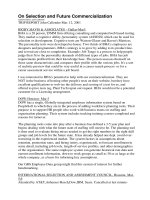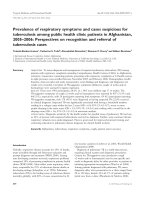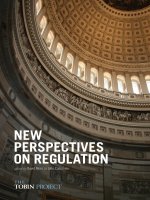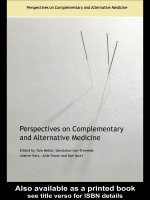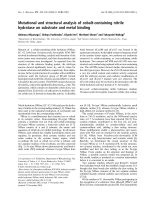NEW PERSPECTIVES ON PRAGMATISM AND ANALYTIC PHILOSOPHY pdf
Bạn đang xem bản rút gọn của tài liệu. Xem và tải ngay bản đầy đủ của tài liệu tại đây (3.71 MB, 172 trang )
NEW PERSPECTIVES
ON PRAGMATISM AND
ANALYTIC PHILOSOPHY
a volume in
Studies in Pragmatism and Values
SPV
VIBS
Volume 228
Robert Ginsberg
Founding Editor
Leonidas Donskis
Executive Editor
Associate Editors
G. John M. Abbarno
George Allan
Gerhold K. Becker
Raymond Angelo Belliotti
Kenneth A. Bryson
C. Stephen Byrum
Robert A. Delno
Rem B. Edwards
Malcolm D. Evans
Roland Faber
Andrew Fitz-Gibbon
Francesc Forn i Argimon
Daniel B. Gallagher
William C. Gay
Dane R. Gordon
J. Everet Green
Heta Aleksandra Gylling
Matti Häyry
Brian G. Henning
Steven V. Hicks
Richard T. Hull
Michael Krausz
Olli Loukola
Mark Letteri
Vincent L. Luizzi
Adrianne McEvoy
J.D. Mininger
Peter A. Redpath
Arleen L. F. Salles
John R. Shook
Eddy Souffrant
Tuija Takala
Emil Višňovský
Anne Waters
James R. Watson
John R. Welch
Thomas Woods
Harvey Cormier , Editor
Amsterdam - New York, NY 2011
Edited by
Rosa M. Calcaterra
NEW PERSPECTIVES
ON PRAGMATISM AND
ANALYTIC PHILOSOPHY
Cover Photo: www.dreamstime.com
Cover Design: Studio Pollmann
The paper on which this book is printed meets the requirements of “ISO
9706:1994, Information and documentation - Paper for documents -
Requirements for permanence”.
ISBN: 978-90-420-3321-4
© Editions Rodopi B.V., Amsterdam - New York, NY 2011
Printed in the Netherlands
Studies in Pragmatism and Values
SPV
Other Titles in SPV
John Shook. Pragmatism: An Annotated Bibliography, 1898-1940. 1998.
VIBS 66
Phyllis Chiasson. Peirce’s Pragmatism: A Dialogue for Educators. 2001.
VIBS 107
Paul C. Bube and Jeffrey L. Geller, eds. Conversations with Pragmatism: A
Multi-Disciplinary Study. 2002. VIBS 129
Richard Rumana. Richard Rorty: An Annotated Bibliography of Secondary
Literature. 2002. VIBS 130
Guy Debrock, ed. Process Pragmatism: Essays on a Quiet Philosophical
Revolution. 2003. VIBS 137
John Ryder and Emil Višňovský, eds. Pragmatism and Values: The Central
European Pragmatist Forum, Volume One. 2004. VIBS 152
John Ryder and Krystyna Wilkoszewska, eds. Deconstruction and
Reconstruction: The Central European Pragmatist Forum, Volume Two.
2004. VIBS 156
Arthur Efron. Experiencing Tess of the D’Urbervilles: A Deweyan Account.
2005. VIBS 162
Leszek Koczanowicz and Beth J. Singer, eds. Frederic R. Kellogg and
Łukasz Nysler, Assistant Eds. Democracy and the Post-Totalitarian
Experience. 2005. VIBS 167
Sami Pihlström. Pragmatic Moral Realism: Pragmatic Moral Realism.
2005. VIBS 171
John Ryder and Gert-Rüdiger Wegmarshaus, eds. Education for a
Democratic Society: Central European Pragmatist Forum. Volume Three.
2007. VIBS 179
Michael Taylor, Helmut Schreier, and Paulo Ghiraldelli, Jr. Pragmatism,
Education, and Children: International Philosophical Perspectives. 2008.
VIBS 192
Hugh P. McDonald. Creative Actualization: A Meliorist Theory of Values.
2011. VIBS 224
CONTENTS
Foreword by Harvey Cormier ix
Introduction by Rosa M. Calcaterra xi
Acknowledgements xxi
ONE Allowing Our Practices to Speak for Themselves:
Wittgenstein, Peirce, and Their Intersecting Lineages
Vincent Colapietro 1
1. Introduction 1
2. Trying to Understand Our Entanglement in Rules
(Our Locus in Practice) 2
3. What’s the Use of Calling Wittgenstein a Pragmatist? 6
4. A Step Back to View the Larger Context 11
5. The Philosophical Recovery of the
Everyday World/The Mundane Reorientation of
Philosophical Investigation 12
6. Conclusion 15
TWO Beyond Scientism
Mario De Caro 21
1. Introduction 21
2. Scientism, Anti-naturalism, and Pragmatism 22
3. The Features of Scientific Naturalism 24
4. The Scientistic Character of Scientific Naturalism 27
5. Some Criticisms of Scientific Naturalism 28
6. The Premises of Scientific Naturalism Again 30
THREE The Entanglement of Ethics and Logic
in Peirce’s Pragmatism
Rossella Fabbrichesi 35
FOUR Indiana James
Maurizio Ferraris 45
1. Are Popes Infallible? 45
2. Transatlantic Truth 46
3. Pacific Truth 49
4. The Automatic Sweetheart 53
5. The Sun and The Moon 55
FIVE Action and Representation in Peirce’s Pragmatism
Nathan Houser 61
SIX Semiotics and Epistemology: The Pragmatic
Ground of Communication
Ivo Assad Ibri 71
1. Introduction 71
2. A Realistic View of Semiotics 71
3. Semiotics and Pragmatism 75
4. Conclusion 79
SEVEN Wittgenstein, Dewey, and Peirce on Ethics
Giovanni Maddalena 83
EIGHT Different Pragmatist Reactions to Analytic Philosophy
Michele Marsonet 101
NINE Pragmatism and Intention-in-Action
John McDowell 119
TEN Pragmatism as Anti-Representationalism?
Eva Picardi 129
1. Introduction 129
2. Metaphors We Steer By 131
3. Inferentialism vs. Representationalism 135
4. “A sentence says just one thing.” 139
About the Contributors 145
Index 149
EDITORIAL FOREWORD
If we judge by recently published anthologies, this is the era of “new” figures
in philosophy. There is a new Nietzsche, who is not just another late Romantic
but who challenges the language and thought of onto-theology; a new Husserl,
who is not merely a semantic theorist of intentionality and the life world but
who also develops a doctrine of non-fictional, Nietzsche-proof, transcendental
subjectivity; a new Wittgenstein, who makes not a simple journey from realism
to anti-realism but a complex transit from one way of ruling out metaphysical
nonsense to another; and, now, perhaps inevitably, there are the new
pragmatists, who see truth not as a mere relative matter of whatever we in our
culture happen to let each other say but as a connection between our thoughts
or words and objective reality.
New pragmatism is not to be confused with neopragmatism; in fact, the
latter philosophy is the nemesis of the “new” pragmatists. The new prag-
matism sets out specifically to challenge the evidently idealistic and relativistic
view that “there is only the conversation.” The neopragmatist way of
understanding truth, thinking, and reality seems to leave humanity tossing in a
sea of arbitrariness, with no real grounds for real criticism of what anyone
might actually do or say. The pragmatic revisionists try to restore the pos-
sibility of criticism by putting us back in touch with the world beyond thought
and language. They set out to locate more objective understandings of truth in
the work of the historical pragmatists, and they make their own new arguments
in favor of attention to “how things are, anyway” and “getting things right.”
Much if not quite all of the work in the present volume fits under the
heading of “new” pragmatism. As these essays connect pragmatism with
philosophical analysis and its history, they show that pragmatists and analytic
thinkers alike have argued for the importance of using logic to deal with
philosophical problems, tried to explain scientific method, and offered
explanations the idea of the real. The pragmatists have emphasized action in
connection with knowledge, and they have emphasized the role of values in
our understanding of logical truth and scientific facts, but this has not been
either a cause or an effect of Protagorean relativism. Instead, the pragmatists
have challenged the idea, present at the birth of analytic philosophy, that facts
and truth are real while values are merely emotional and relative. That tenet of
logical positivism has fallen by the wayside as analytic philosophy has
developed more sophisticated things to say about both science and morality,
and, over the course of the last half of the twentieth century, some analytic
thinkers have found pragmatism to be more of a complement and less of a
competitor.
Editorial Foreword
x
The work in this book will help thinkers in both pragmatic and analytic
camps understand and constructively criticize both traditions, and it will help
pave the way for future cooperation among thinkers in two of the most
productive schools of contemporary philosophical thought.
Harvey Cormier
Editor, Studies in Pragmatism and Values
INTRODUCTION
Rosa M. Calcaterra
The lively presence of pragmatist doctrines in early 20th-century international
debate, their subsequent slow and apparently inexorable decline, and their
recent revival are intertwined with the fate of other currents of thought that
have marked the revision of traditional philosophical systems. This volume
aims to clarify the most recent developments in this process, focusing on the
key theoretical issues in the revival of salient themes in the classic tradition of
American philosophy within the context of analytical thought. It will also
pinpoint the differences and interactions between these two forms of
speculation that, for some time, mutually disregarded one another.
The essays in this volume are largely based on the papers presented at
the international conference “Pragmatismo e filosofia analitica. Differenze e
interazioni,” held in Rome in March 2005, with the participation of the Center
for American Studies in Rome, the American Embassy in Italy, Roma Tre
University and the Presidency of the Lazio Region. The wide-ranging
discussion between the speakers and the audience at this event evinced a
lively interest in the themes considered. It also demonstrated both the current
tendency of analytical philosophers to define the historical context of their
methods of investigation and the commitment of scholars of pragmatism to
clarifying the originality and theoretical depth of its canonical works.
The pragmatist tradition dominated the American academic scene until
the 1930s, when the different strands of analytical philosophy began to
develop, introduced by scholars linked to the Vienna Circle – Reichenbach,
Carnap, Hempel, Tarski, Neurath and others – who were forced to leave
Europe for political reasons. As Richard Bernstein has noted, this period saw
the beginnings of a sort of “silent revolution,” which over the space of a few
years led to the exclusion of pragmatism from the higher levels of
philosophical debate. The project for a “scientific philosophy,” upheld by
those who had imported logical neopositivism from Europe, was warmly
welcomed in pragmatist circles and occasioned a lively debate which led to
the International Encyclopaedia of Unified Science initiative, promoted by
John Dewey and Charles Morris. However, the view soon spread that the
pragmatists, despite having anticipated the criterion of the verifiability of
meaning on which neopositivist thought depended, lacked logical and
epistemological rigor. Their works were considered a sort of prehistory of
American philosophy, which became increasingly technical and specialized.
In Europe, despite the scathing critiques of influential academics like
Bertrand Russell, Francis H. Bradley, George E. Moore, Benedetto Croce, and
INTRODUCTION xii
of Giovanni Gentile, pragmatism remained a vital presence during the first
two decades of the twentieth century. It offered an alternative to neo-
Hegelianism, to positivist philosophy, and to the various forms of neo-
criticism of Kantian derivation. The subsequent establishment of new currents
of thought – phenomenology, Marxism, hermeneutics – led to the near
disappearance of pragmatism. Nevertheless, pragmatism returned, especially
in Italy, during the aftermath of the First World War, becoming a reference
point for liberal democratic laicism. During this phase, attention was devoted
almost exclusively to Dewey, and to his commitment to politics and
pedagogy, while other pragmatists were mostly ignored by European
intellectuals. Indeed, the criticism of the academic establishment at the
beginning of the century had led to pragmatism as a whole being widely
discredited, and the movement continued to lose ground following some new
and extremely harsh critiques. I refer especially to György Lukács who, in his
important 1954 work, Die Zerstörung der Vernunft, labelled pragmatism as
the philosophy of American imperialism, and to the brief but incisive
judgements expressed by Heidegger, Horkheimer, and Adorno, who spread
the conviction that pragmatist attitudes represented a style of thought wilfully
divorced of any principles beyond those of utility and success “here and
now.”
Towards the end of the 1960s, the judgements of these authors were
sidelined and, through the controversies about the “modern” and the “post-
modern” inspired by their works, the theoretical legacy of Peirce, James,
Mead, and Dewey began to affect the formulation of the new problems of
practical philosophy. During the same period, analytical philosophers
consolidated their tendency to question the neopositivist epistemological
paradigm. Within this critical movement, the references to pragmatism in
Quine’s The Two Dogmas of Empiricism (1951) allowed for the modification
of a series of standard notions in logical neoempiricism. The interaction of
pragmatist ideas with the development of “post-positivist” analytical
philosophy and the practical philosophy of the second half of the twentieth
century has to do with the contemporary problem of determining if and how a
constructivist viewpoint can be reconciled with the relativist mentality
generated by the crisis of traditional models of rationality.
These interactions are often extremely muted (sometimes only
recognizable by those who are familiar with classic pragmatist texts) precisely
because they form part of the complex range of themes brought into play in
philosophical debate. In other words, the “pragmatic turn,” now generally
attributed to epistemology and practical philosophy, consists of a way of
tackling current problems that leads to the re-emergence of some of
pragmatism’s typical concerns. However, this takes the form of a multiplicity
of reinterpretations dictated by the interests and theoretical standpoints of
individual authors, who generally do not intend to repropose one of the
specific doctrines developed within this movement. In any case, there are now
INTRODUCTION xiii
numerous forms of neopragmatism which sometimes differ profoundly but
which nonetheless demonstrate the vitality of a movement that from its
origins was characterized by a variety of aspects and directions.
The current tendency to abuse the term “pragmatism” aside, in
technical debate this word retains its original meaning of a philosophical
method tailored to specific theoretical aims. Examples of such aims are: to
overcome the various forms of dogmatism that run through the history of
Western thought; to construct a concept of rationality able to incorporate
Darwinism in order to challenge philosophies based on the notion of
consciousness as the autonomous “essence” of cognitive activity, morality,
and human experience in general; to assert the processual, social, and
potentially fallible nature of every knowledge. The convergence of these aims
with the pragmatist concept of action, according to which this constitutes a
precise reference point for recognizing the interconnection between rational
and empirical knowledge factors, led to a philosophical alternative to
traditional empiricism and ration-alism.
More importantly, the concept of action served to critique traditional
foundationalism and reconstruct the notion of “foundation” through an
approach to the concepts of knowledge, truth, and objectivity that emphasises
the variety of their constitutive factors – including specific theoretical and
methodological choices, all preconstituted beliefs, logical-semantic
presuppositions, and more or less explicit metaphysical outlooks. The view of
classical pragmatists that our cognitive practices can be debated in a way that
may lead us to abandon one or more of the propositions that derive from them
– a frequent occurrence in the history of scientific research – does not imply a
rejection of the ideas of truth and objectivity themselves. On the contrary,
their works suggest that truth and objectivity cannot be conceived in terms of
the absolute while defending the indispensable function played by these
notions in the various fields of knowledge as well as in the concrete nature of
our interactions with the physical world and with other human beings.
1
The authors who have contributed to this volume bring new
developments and historiographical analyses to bear on the main issues raised
by this new season of pragmatism. I will therefore give a brief overview of its
best-known protagonists in order to provide a basic theoretical background to
the individual essays. These together form a multi-voiced conversation that
signals a common interest in cultivating the ethical and social significance of
philosophical thought.
The “pragmatic turn” in contemporary thought has particularly
emphasised this aspect, finding paradigmatic expression in the practical
philosophy of Jürgen Habermas and Karl-Otto Apel. These two philosophers
have developed a pragmatic version of the theme of normativity that has
become an effective tool for challenging the scepticism and relativism that
have accompanied twentieth-century criticism of traditional philosophical
systems. The theme of normativity is hotly debated in current analytical
INTRODUCTION xiv
philosophy, and the pragmatic approach of some parts of Wittgenstein’s
Philosophical Investigations and especially On Certainty, has given rise to
interpretations of this theme that share much with the anti-sceptical aims of
Apel and Habermas.
2
Unlike most theorists of post-modernity, Apel and Habermas do not
deny the principle of the universality of moral norms, and attempt instead to
reconstruct it through an analysis of communicative processes. This recon-
struction is inspired by Kantian ethical rationalism and the pragmatist attempt
to uphold the regulatory function of the concepts of truth and objectivity.
Seen in this light, a return to pragmatism signifies gathering up the threads of
the Enlightenment project of a philosophical foundation for ethics and
exploiting the shift from subjectivity to the epistemological paradigm of
intersubjectivity which signals the continuity between pragmatist
philosophers and the “linguistic turn” in twentieth-century thought. More
precisely, it means setting aside the idea of individual consciousness in favour
of notions of “linguistic subject” and “communicative action” in order to
define the conditions under which rational arguments are possible and the
criteria for their objective validity in science and ethics. The outcome of this
program is a new functionalism that relies on a consensus theory of truth,
emphasizing the performative dimension of discourse rather than its
prepositional content.
The hypothesis of an “ideal communicative situation,” one free of
external restrictions on the logic of discursive communication (which requires
the participants in discourse to enjoy equal opportunities to arrive at an
intersubjective consensus) has led to a reevaluation of the Kantian
transcendental approach to the problem of rationality. Apel has proposed that
this approach be applied systematically, developing a “pragmatic-
transcendental” foundation for ethics. According to him, the aim is to
continue Pierce’s transformation of Kantian transcendental philosophy into a
“transcendental semiotics”; indeed, the notion of the “unlimited community of
rational argumentation” upon which Apel’s “universal pragmatics” hinges
refers expressly to Pierce.
3
The transcendental course embarked upon by Apel
has met with more criticism than consensus within the neopragmatist
movement, and even Habermas has gradually distanced himself, preferring an
increasingly historicist approach to the justification of ethical norms, which
seems more in keeping with the overall approach of the pragmatists.
However, the fact remains that Apel and Habermas have placed the
analysis of the pragmatic aspects of language at the center of their own
interests. This parallels an important branch of analytical philosophy
developed in the second half of the twentieth century at Oxford and in the
United States: the philosophy of ordinary language of authors such as John
Austin and John Searle. Like the two German philosophers, theorists of
ordinary language analyze utterances not in themselves but as “acts” produced
by the speakers; in this case, however, it would be excessive to speak of
INTRODUCTION xv
pragmatist influences. By contrast, there is currently considerable effort to
locate the problems of meaning and interpretation within the framework of a
“linguistic pragmatism” that, adopting suggestions by Richard Rorty, draws
on the “late” Wittgenstein and the anti-Platonist line taken by Willard Quine,
Wilfrid Sellars, and Donald Davidson.
4
Returning to Habermas, we should remember that, even before Apel,
he clarified the linguistic component of the logic in Pierce’s research in his
Erkenntnis und Interesse (1968), which laid the groundwork for his own
“theory of communicative action.” Later, by contrast, he revived Mead’s
intuitions regarding the pragmatic matrix of communication – its role in the
evolution of moral norms and the processes of democratization of political
life. Specifically, Habermas credits Mead with developing the basic
theoretical concepts of the ethics of communication, in other words, the
notions of “universal discourse” and the “formal ideal of linguistic
comprehension.” Above all, for Habermas, Mead’s importance lies in having
clarified that rationally motivated comprehension is not merely a requirement
of practical reason, but rather is incorporated into the reproduction of social
life, and in having demonstrated the link between the spread of democratic
ideas and the transformation of the criteria legitimating the modern state.
5
The project of a discursive theory of democracy and law, which
Habermas continues to develop alongside his universalist ethics, brings to the
fore some characteristic traits of pragmatism, as we can see, for example, in
his analysis of the relationship between the contemporary state of affairs and
modernity’s Enlightenment roots.
6
Above all, there are echoes of the pragmatist concept of action as an
exemplary dimension of the unity of logical-formal and empirical-material
factors in human experience in his insistence on the need to overcome the
binary schemes inherited by continental European thought from Cartesian
philosophy. In the context of social and political philosophy, this entails
recognizing that action does not tolerate a dualism of material interests and
values; values are incorporated within the rational dimension of action and
they govern strategies for the fulfilment of material interests. More generally,
this recognition is linked to the contemporary awareness of the “imperfect”
nature of rationality and entails the need – also expressed by the “non-
causalist” analytical theories of action – to conceive of the justification of
rational action in terms of a double explanatory code: one that concerns the
objective limitations, potentialities, and responsibilities of each individual,
and also concerns the beliefs, projects, and imperatives deriving from his or
her existence as a social subject.
7
The tendency to translate the concept of “foundation” into
“justification” also forms an integral part of the thought of Hilary Putnam,
which represents a milestone in recent interactions between pragmatism and
analytical philosophy. Unlike Rorty, who should be credited with a major
contribution in refocusing attention on classic pragmatists, Putnam believes
INTRODUCTION xvi
that Pierce, Dewey, and James developed a decontextualized philosophical
terrain on the basis of which it is possible to contain the attacks of
contemporary thought on the bastions of traditional foundationalism.
Specifically, they provided the conceptual tools with that give the democratic
ideas of tolerance and pluralism an epistemological justification, safeguarding
them from the sceptical implications of ethical and religious relativism, while
avoiding the trap of moral authoritarianism. At the same time, their works
made it possible to establish normative criteria for scientific enquiry, while
avoiding the dogmatic pretensions of apriorism. Consequently, he defends a
constructivist perspective, drawing on the pragmatists’ affirmation of the
fallibility of theoretical acquisitions and their faith in the possibility of
constructing logical and behavioral habits corroborated by the intersubjective
agreement of reasoning on experience.
Putnam’s promotion of an epistemology capable of avoiding the classic
opposition between realism and anti-realism includes the conception of truth
as a limiting concept, both of the linguistic-conceptual schemes that we
ordinarily use and the logical and empirical procedures of scientific research.
The presupposition of a progressive move towards factual reality is thus a
fundamental normative principle of our speech. Renouncing this
presupposition leads to a relativism inconsistent with the actual execution of
our logical-semantic functions. This is one of the main theses of the “internal
realism” developed in Putnam’s works published between 1975 and 1991,
where he stresses the ability of scientific research to achieve “genuine”
knowledge that is “justified” both by its technical application and by the
resolution of theoretical discrepancies enabled by the development of the
individual sciences and their interactions.
8
Putnam’s appeal to pragmatism to challenge the puzzles of the
realism/antirealism dichotomy gradually takes the shape of a dialogic
conception of rationality that combines individual responsibility and the
concept of community, naturalism and the relational approach to the problem
of epistemic intermediaries, and finally the dimension of facts and that of
values. The latter aspect is sanctioned by Putnam’s recent work, The Collapse
of the Fact/Value Dichotomy and Other Essays (2002), which explicitly refers
to the importance of the challenge launched by classic pragmatists on a
conceptual opposition whose roots lie in Hume’s empiricism and which,
through the Kantian distinction between synthetic and analytic judgements,
has become established to the point of becoming a genuine cliché. Indeed, the
entanglement of facts and values is one of pragmatism’s fundamental
strengths, and Putnam understands that this also holds true for Pierce, often
considered a champion of the separation of science from ethics, in other
words of that separation of judgements of fact from judgements of value
insisted on by neopositivists. In his commentary on the first of the
“Cambridge Lectures” held by Peirce in 1898, dedicated to precisely this
problem, he observes that although Peirce’s conclusions were in line with the
INTRODUCTION xvii
common tendency of his time to propose a classification of the sciences on
the basis of distinctions between their methods and objectives, Peirce’s
classificatory effort “was based on deeper principles than the classification”
and that ultimately, “Peirce burst the frame of the culture that produced him.”
9
Putnam also rightly observes that the classification of the sciences is
something that has essentially disappeared from the intellectual scene today.
However, it is evident that the clarification of epistemic and methodological
distinctions is anything but obsolete, and he himself strives to demolish the
dichotomy between the logic of facts and that of values. If this means we
must set aside “architectonic” intentions, we should reconsider Peirce’s
discourse on the intimate relationship between the normative sciences (ethics,
logic, aesthetics), if for no other reason than to draw from it ideas for
developing what he termed “concrete rationality.”
The anti-dichotomic stance of the pragmatists has been widely
underscored by its interpreters, and Rorty uses it as a point of reference for
transferring fundamental philosophical terms – objective, subjective, internal,
external, nature, spirit, fact, value – from the paradigm of foundationalist
epistemology to that of hermeneutic-historicist philosophy. The arguments
between Putnam and Rorty have led to a wide-ranging debate on their
interpretations of pragmatism, which produced and continues to produce
important results on the historiographical level, and also for the reconstruction
of the shift from neopositivist to post-positivist analytical epistemology.
However, from the standpoint of theory, to ask which of the two is the most
faithful interpreter of the classic tradition of American philosophy is an
irrelevant question. What is important is the fact that the different
interpretative paths taken by Rorty and Putnam reflect not only two different
ways of understanding the task of philosophical reflection, but also many of
the current divergences in the formulation of the classic problems of
epistemology, such as those of truth, the relationship between perceptions and
judgements, between the mind and the body, between socio-cultural and
natural aspects of human interactions with reality, and finally the relationship
between ethics and logic. The essays in this volume demonstrate that the texts
of Peirce and his companions, directed against Descartes andKantian
transcendentalism, and developing Darwin’s evolutionary theory and the
nascent scientific psychology in a wholly original way, help usto answer the
questions which today’s philosophy has inherited from traditional
epistemology. However, this means that it is above all necessary to determine
to what extent the problems of the past can be translated into those of today,
bearing in mind that the paths indicated by the pragmatists for the
reformulation of philosophical research – especially to break with
dichotomies and false dilemmas, such as subjective/objective, epi-
stemic/ethical, empirical/rational, internal/external – have in the meantime
both encountered new obstacles and developed in new directions.
INTRODUCTION xviii
Seen in this light, Rorty’s conviction that reevaluating pragmatism is
equivalent to building a bridge between analytical and “continental”
philosophers can also be understood as an invitation to make different
viewpoints interact, without necessarily having to depart radically from our
gnoseological tradition. I refer especially to the possibility of interpreting the
continuity and divergences between the pragmatists, Kant, and Hegel with the
tools of analytical philosophy, in order to tackle the theme of epistemic
intermediaries which lies at the heart of the debate between naturalists and
anti-naturalists, realists and anti-realists. Rorty’s “historicist nominalism”
rightly abandons the idea that tertia play a representationalist role of the
Cartesian or Lockian type. However, we may ask ourselves, for example, if
reflection on language really requires us to choose between Rorty’s
inferentialism and the representationalism of thinkers like Ramsey and Fodor;
and in any case, if a systematic theory of meaning is superfluous if we wish to
understand the cognitive aspects of language as a tool for reflection and
communication. Furthermore, the socio-linguistic world, on which Rortian
neopragmatism focuses, may also include a principle of correspondence with
reality, without which it would be difficult to recognize the objective
limitations of our operative possibilities and our cognitive goals. In more
general terms, it remains to be seen whether taking cultural history as the
determining factor in the evolution of our conceptual schemes suffices to
resolve the problem of deciding whether logical capacities are the result of
biological evolution or the autonomy of human intelligence.
Recent analytical philosophy has employed sophisticated forms of
naturalism (computationalism, supervenience, eliminativism, extensionalism)
that fail to answer many questions regarding specifically human abilities,
normativity, and the social and moral aspects of our logical and practical
skills. If we read the texts of classic pragmatists with care, we will regard the
argument between naturalists and anti-naturalists as an improvident conflict
between science and philosophy, one that Rorty has not mitigated with his
statements of their common nature as “creative” activities. The naturalist vein
running through the works of Peirce, James, Dewey, and Mead maintains the
distinction between science and philosophy, recalling the need to establish a
synergy between philosophical and scientific research on human beings. This
should take the form of a theoretical dialogue that exploits the potential of
both philosophy and science for increasing our knowledge of the relevant
phenomena and thus for implementing a plurality of ways of tackling the
various problems facing us. Above all, these authors should be credited with
having left open the question of the relationship between the physical and
mental, avoiding absolutist metaphysical choices – both of the spiritualist and
the materialist type – which risk compromising the concrete difficulty of the
problems and needs that constitute our individual and social lives.
Rorty’s wavering between naturalism and historicism nonetheless
recalls us to the task of verifying the notion of sociality so dear to the “old”
INTRODUCTION xix
pragmatists, opposed to all rigidly reductionist principles and facile
Darwininan criteria, with the confirmation that this notion is currently
achieving in the field of neuroscience. This implies careful reflection on the
role of intersubjectivity with respect to our ability to interact successfully with
the world around us. As such, while admitting that “truth” is not a purely
objective entity or metaphysical concept, is it sufficient to think that there are
no extra-linguistic criteria or ends, as Rorty suggests? In this context, it is
worth noting that Quine, Davidson, and Sellars, authors on whom Rortian
neopragmatism draws to suggest an interaction between post-positivist
analytical philosophy, Hegel, Nietzsche, Heidegger, and Gadamer, do not
abandon the realist criterion, but rather reformulate in an attempt to overcome
the conflict between empiricism and logicism. In other words, we can agree
with Rorty in seeing in Quine, Sellars, and Davidson the allies of classic
pragmatists, but for different reasons. Quine’s famous challenge to the
distinction between analytic and synthetic propositions touched on a key point
in pragmatist philosophy: the assertion of interference between the logical
dimension and the empirical dimension. Furthermore, we can find in Peirce,
Dewey, and Clarence Irving Lewis – one of Quine’s teachers – the principle
according to which the analysis of scientific propositions must be undertaken
considering the theoretical and empirical context of individual statements.
This implies that the truth and meaning of scientific propositions cannot be
reduced to so-called sense-data–and also that the set of empirical and logical
evidence used on any given occasion to justify a theory cannot be taken as
definitive proof of its truth. Although Quine thus restated the anti-dualist and
fallibilist attitude of classic pragmatists, he nevertheless did not abandon the
conviction that the experience of events was a sure, albeit complex, way of
knowing something of their reality.
Similarly, Sellars’s attacks on the “myth of the given,” which adopted
the epistemological criterion of intersubjectivity on which Pierce had based
his logical “socialism,” did not imply a conventionalist or anti-
representationalist conception of truth. On the contrary, he stated that
scientific propositions are “interpretative” representations of reality, and that
they are true exactly insofar as they manage to transfer the non-linguistic into
linguistic form. Finally, Davidson’s coherentism includes, as he himself
notes, a sophisticated form of correspondentism, in other words a
correspondence between beliefs and reality without direct comparison. His
rebuttal of what he calls “the third dogma of empiricism,”–the distinction
between “conceptual scheme” and “empirical content”– does not stop him
from repeating, in his theory of “triangulation,” that the concepts of truth and
objectivity gain substance in intersubjective communication, which
presupposes that human beings share at least the basic ways of receiving
experiential data and reacting to physical stimuli.
Finally, pragmatism and analytical philosophy have marked the entire
development of twentieth-century North American philosophical culture, and
INTRODUCTION xx
this volume aims to represent a moment of reflection on the unfolding of the
dialogue between these two lines of thought that has taken place in recent
decades. Studies are currently underway on little-known philosophers who
acted as intermediaries between American realism and the logical empiricism
imported from Europe. This will show that the latter was not extraneous to the
American cultural context and will also renew the ties between realism and
pragmatism. Perhaps this will allow us to avoid pragmatism’s becoming too
rapidly placed in opposition to the original aims of analytical philosophy, and
to understand that its history reflects the typical pattern followed by the
evolution of philosophical ideas. That is to say, the fact that this is essentially
a history of questions and attempts to answer them that, in turn, open up new
questions that may lead to the reappearance of needs or suggestions
previously set aside.
NOTES
1. For a philological reconstruction of these aspects, see Rosa Calcaterra,
Pragmatismo: i valori dell’esperienza. Letture di Peirce, James e Mead (Rome:
Carocci, 2003).
2. See Normatività fatti valori, ed. R. Egidi, M. De Caro, M. Dell’Utri
(Macerata: Quodlibet, 2003).
3. K. O. Apel, Trasformation der Philosophie (Frankfurt a. M.: Suhrkamp,
1973); K.O. Apel, Der Denkweg von Charles S. Peirce (Frankfurt a. M.: Suhrkamp
Verlag, 1975). See also his essay C.S. Peirce and the Post–Tarskian problem of an
Adequate Explication of the Meaning of Truth: Towards a Trascendental– Pragmatic
Theory of Truth, in The Relevance of Charles Peirce, ed. E. Freeman (La Salle: The
Monist Library of Philosophy, 1983).
4. See R. B. Brandom, Articulating Reasons: An Introduction to Inferentialism
(Cambridge, Mass.: Harvard University Press, 2000).
5. J. Habermas, Theorie des Kommunikativen Handelns vol. II (Frankfurt a.
M.: Suhrkamp, 1981). See also J. Habermas, The Paradigm Shift in Mead, in
Philosophy, Social Theory, and The Thought of G. H. Mead, ed. M. Abulafia (Albany:
SUNY Press, 1991).
6. J. Habermas, Faktizität und Geltung. Beitrage zur Diskurstheorie des recht
und des demokratischen Rechsstats (Frankfurt a. M.: Suhrkamp Verlag, 1992).
7. See for example G. H. von Wright’s neo–Wittgensteinian theory of action, a
reconstruction of which can be found in R. Egidi, “Von Wright and “Dantes’s Dream”:
Stages in a Philosophical Pilgrim’s Progress,” in In Search of a New Humanism. The
Philosophy of Georg Henrick von Wright, ed R. Egidi (Dordrecht–Boston–London:
Kluver Academic Publishers, 1999).
8. See in particular H. Putnam, Realism with a Human Face (Cambridge,
Mass.: Harvard University Press, 1990), pp. 232–51 and pp. 217–31.
9. Reasoning and the Logic of Things, ed. H. Putnam & Kenneth L. Ketner
(Cambridge, Mass.: Harvard University Press, 1992).
ACKNOWLEDGEMENTS
A good number of these essays were prepared for the international
conference “Pragmatismo e filosofia analitica. Differenze e interazioni,” held,
at the Center for American Studies in Rome in March 2005, while several
others stem from the extensive debate that took place in that occasion.
Particular thanks go to the American Embassy in Italy, which offered most
part of the financial support to the Conference, as well as to the Presidency of
Lazio Region and to the Center for American Studies in Rome, expecially to
its director Karim Mezran, both of which generously contributed to the
success of the event. I also thank the Department of Philosophy of Roma Tre
University for the support to the publication of this volume.
I am very grateful to Nicolas Leon for his copy-editing. He has been
very helpful in improving the texts and always very kind in discussing his
suggestions with the authors. I wish to express my gratitude to Harvey
Cormier, the editor of Rodopi, to Giovanni Maddalena for his continuous
encouragement and sound advices, and to Maria Luisi for indexing this book.
Permission given by Quodlibet publisher to reprint some of the essays
previously appeared in the book “Pragmatismo e filosofia analitica.
Differenze e interazioni” (2006) is gratefully acknowledged.
One
ALLOWING OUR PRACTICES TO SPEAK FOR
THEMSELVES: WITTGENSTEIN, PEIRCE,
AND THEIR INTERSECTING LINEAGES
Vincent Colapietro
1. Introduction
Ludwig Wittgenstein explicitly denies that he is a pragmatist and, in turn,
many contemporary pragmatists strenuously resist the possibility that the
affinities between the later Wittgenstein and the classical pragmatists are
anything but superficial. More than anything else, the question of quietism
seems to mark, from the perspective of such pragmatists, a difference that
makes a decisive and fundamental difference. Wittgenstein insists:
“Philosophy may in no way interfere with the actual use of language; it can in
the end only describe it.”
1
He adds: “It leaves everything as it is.”
2
In contrast,
William James (a thinker who influenced Wittgenstein) asserts:
The really vital question for us is, What is this world going to be?
What is life eventually to make of itself? The centre of gravity of
philosophy must therefore alter its place. The earth of things, long
thrown into shadow by the glories of the upper ether, must resume its
rights.
3
For James, then, the truly central question is, What are we going to make of
our lives and thus of the world in which we are destined to live our lives? For
Wittgenstein, the question does not seem to concern the self in its relationship
to the world, in the same sense as that preoccupying the pragmatists. But it
unquestionably concerns just this relationship, though in a way in which
issues of patience and forbearance, the acceptance of finitude and discipline
of self, are more prominent than those of melioration and reparation, the
reconstruction of institutions and remaking of our practices.
The purpose of this paper is obliquely to consider the self in
relationship to the world by directly considering questions about practice
(thus, ones about our engagement in, indebtedness to, and estrangement from
the practices in and through which human lives acquire their singular shapes).
Allowing Our Practices to Speak for Themselves
2
This is done in reference to the later Wittgenstein and the classical
pragmatists. That is, our concern is with the practical (or pragmatic) meaning
of practice, as this meaning is illuminated by Wittgenstein and pragmatism.
The clarification of this meaning carries implications for how we ought to
conceive, most likely reconceive, the self in its relationship to the world. It
also carries implications for how the philosophical recovery of the everyday
world of human experience might be accomplished and, of greater urgency,
why it must be undertaken. Such recovery both enjoins an acceptance of our
finitude and underwrites certain struggles against the actual limits of our
inherited worlds. It takes seriously the possibility that human consciousness
is, at bottom, exilic consciousness, that human identity is, especially in our
epoch, “diasporic identity.”
4
But it does so in ways refusing to succumb to the
persistent pressure of a largely unacknowledged romanticism, especially that
form of romanticism rooted in the quite local ideal of a rootless
cosmopolitanism. Such a recovery takes local attachments and actual place,
historical contingencies and natural habitats, with utmost seriousness.
In the end, part of the answer to the question, “What’s the use of
calling Wittgenstein a pragmatist?” is bound up with the vital contribution of
the later Wittgenstein to the pragmatic clarification of questions concerning
human practices (thus, ones concerning human identity and involvement),
questions unquestionably central to pragmatism. The danger of losing the
distinctive voice of this singular philosopher by identifying him too closely
with pragmatism is offset by the greater risk of failing to clarify adequately,
by eschewing his guidance and example, the pragmatic meaning of human
practices. One way to examine the relationship between analytic philosophy
and American pragmatism is to explore the intersecting lineages of Peirce and
Wittgenstein in reference to a pivotal issue (one central in both lineages), for
the purpose of addressing this question.
5
The question of practice – in truth, a
cluster of questions – is especially promising in this respect.
2. Trying to Understand Our Entanglement in Rules (Our Locus in
Practice)
In On Certainty, Ludwig Wittgenstein observes: “Not only rules, but also
examples are needed for establishing a practice.”
6
While human practices are
governed and indeed defined by constitutive and other kinds of rules, they are
not so tightly and completely bound by rules that their institution,
maintenance, and indeed revision are solely or even mainly explicable in
reference to following rules. Emphasis upon the rule-governed character of
human practices, thus, should not be confused with the formalist dream of
identifying a finite set of explicit rules underlying the only apparently messy
affair of historically evolved and evolving practices. These practices rather
are inherently and irreducibly messy and improvisational. Indeed, they might
be best described as occasions and resources for improvisations. At any rate,
VINCENT COLAPIETRO 3
practices are exemplified as much, if not more, than regulated: arguably, the
dramatic, exemplary performances of competent practitioners are primary,
while codifiable, explicit rules are at most secondary.
7
Of course, most of the
constitutive rules of any human practice are made manifest and attractive by
such performances: rules, but also much else, are explained, justified, and
learned through exemplification. In reference to human practices, then, the
importance of constitutive rules cannot be gainsaid, but the status, character,
and operation of these rules is open to a host of questions.
Immediately after observing that examples along with rules are needed
to establish a practice, Wittgenstein adds: “Our rules leave loop-holes open,
and the practice has to speak for itself.”
8
The seemingly rudimentary level of
human activity which he is willing to accord the status of practice is made
clear by the example he himself gives of the point just made: “We do not
learn the practice of making empirical judgments by learning rules; we are
taught judgments [Urteile] and their connexion with other judgments. A
totality [Ein Ganzes] is made plausible to us.”
9
Judging whether sugar is
sweet, the position of the table is alterable, or the dog is fearsome is a practice
or, possibly, a family of practices. We learn to make empirical judgments not
in an atomistic fashion (“we are taught judgments and their connexion with
other judgments”), but in an expansive context.
10
Learning to make such
judgments is the initiation into a situated, social practice; for the learner, the
context of initiation is a narrowly bounded one, but very quickly the context
becomes as the direct result of more effectively integrated competencies an
expansive one. Moreover, such judgments are not so much taught as learned
by us in reaction to the warnings, corrections, and explanations of others.
Though one can learn on one’s own (that is, without teachers), the
circumstances on which I am focusing here are ones in which “teachers” are
present, thus, ones in which learning and teaching are correlative activities.
Hence, when I stress such judgments are not so much taught as learned, I am
simply emphasizing the agency of the learner, though in practical response to
environing conditions (including the intelligent interventions of other human
agents and the unexpected outcomes of the unwitting learner’s own physical
engagements – the attempt to hold the flame in her fingers or to move the
table with the whole of one’s body).
11
They are spontaneously made by
irrepressibly active organisms and continuously corrected or modified as a
consequence of the objections prompted by our exertions (both the objections
of other human beings – for example, “Don’t touch the stove!” – and those
emanating directly from the object itself – for example, the experience being
burned).
12
That is, we as situated actors (or implicated agents) are taught by
other persons and indeed also by physical objects the immediately practical
meaning of our own exertions and the judgments embodied in these strivings
(for example, the judgment that what is delightful to sight must also be
delightful to touch).
13
Under the tutelage of other persons and things, then, we
as spontaneous actors learn to make empirical judgments.
Allowing Our Practices to Speak for Themselves
4
These judgments are not made in isolation from one another or from
the circumstances in which desires, fears, and other impulses are continuously
operative. These judgments are not only made by agents but also ordinarily
take the form of action (the child reaching to touch the dancing flame of a
candle is, in the act of reaching to touch this flame, in effect judging).
Running away from the dog is, in itself (that is, apart from any verbal
articulation or conscious attribution), a somatic, affective judgment: running
away is itself a judgment.
What are given are hence not disjoined data requiring an intelligent
synthesis. What is given is rather life, though not in any amorphous, abstract
sense. That is, what is given is life in a structured, concrete sense – a form of
life more or less recognizably human or, at least, intelligible to humans
14
“What has to be accepted, the given is – so one could say – forms of life
[Lebensformen].”
16
In the context of a Lebensform, we learn to make
empirical judgments under the direct tutelage of respondent others, a sign that
all of our learning assumes the structure of a dialogue (an ongoing give-and-
take between self and the world in which the self is situated and indeed
implicated). The capacity to make such judgments is, as already noted,
accorded by Wittgenstein the status of a practice.
Because the rules by which our practices are partly defined “leave
loop-holes open,” we must grant our practices opportunities to speak for
themselves (“die Praxis muß für sich selbst sprechen”).
17
In his way,
Wittgenstein is committed to a form of investigation in which practices are
granted such opportunities, while the pragmatists in their somewhat different
way are no less committed to just this task. Thus, one way in which to bring
into focus their affinities and differences is to consider how Wittgenstein on
the one side and the pragmatists on the other provide in their writings for such
opportunities. It might be objected that these philosophers are speaking for the
practices under consideration rather than allowing for the practices to speak
for themselves. But their speaking is acknowledged on both sides as a mode
of action.
18
Moreover, it is undertaken ultimately for the sake of facilitating
other modes of action and engagement, ones not requiring a justification by
appeal to anything outside of these activities or engagements. These
ungrounded ways of acting thus turn out to be self-grounded affairs.
But Wittgenstein’s insistence upon practices speaking for themselves
might be taken in a somewhat narrow sense, meaning only that the weight and
authority of a practice, apart from what has been or even what can be
explained in reference to rules, be granted their due. His remark might
however be taken in a wider sense, one implying the primacy and (in a sense)
also the ultimacy of practice. This sense is, arguably, warranted by other
passages in the writings of the later Wittgenstein, most notably, a famous text
on which much ink has been spilled and around which important debates have
turned.
19
